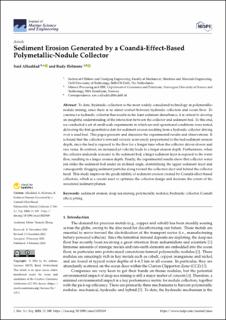| dc.contributor.author | Alhaddad, Said | |
| dc.contributor.author | Helmons, Rudy | |
| dc.date.accessioned | 2023-09-08T07:20:00Z | |
| dc.date.available | 2023-09-08T07:20:00Z | |
| dc.date.created | 2023-03-10T16:00:02Z | |
| dc.date.issued | 2023 | |
| dc.identifier.citation | Journal of Marine Science and Engineering. 2023, 11 (2), . | en_US |
| dc.identifier.issn | 2077-1312 | |
| dc.identifier.uri | https://hdl.handle.net/11250/3088087 | |
| dc.description.abstract | To date, hydraulic collection is the most widely considered technology in polymetallic-nodule mining, since there is no direct contact between hydraulic collectors and ocean floor. To construct a hydraulic collector that results in the least sediment disturbance, it is critical to develop an insightful understanding of the interaction between the collector and sediment bed. To this end, we conducted a set of small-scale experiments in which several operational conditions were tested, delivering the first quantitative data for sediment erosion resulting from a hydraulic collector driving over a sand bed. This paper presents and discusses the experimental results and observations. It is found that the collector’s forward velocity is inversely proportional to the bed-sediment erosion depth, since the bed is exposed to the flow for a longer time when the collector drives slower and vice versa. In contrast, an increased jet velocity leads to a larger erosion depth. Furthermore, when the collector underside is nearer to the sediment bed, a larger sediment layer is exposed to the water flow, resulting in a larger erosion depth. Finally, the experimental results show that collector water jets strike the sediment bed under an inclined angle, destabilizing the upper sediment layer and consequently dragging sediment particles along toward the collection duct and behind the collector head. This study improves the predictability of sediment erosion created by Coandă-effect-based collectors, which is a crucial asset to optimize the collector design and decrease the extent of the associated sediment plumes. | en_US |
| dc.language.iso | eng | en_US |
| dc.publisher | MDPI | en_US |
| dc.rights | Navngivelse 4.0 Internasjonal | * |
| dc.rights.uri | http://creativecommons.org/licenses/by/4.0/deed.no | * |
| dc.title | Sediment Erosion Generated by a Coandă-Effect-Based Polymetallic-Nodule Collector | en_US |
| dc.title.alternative | Sediment Erosion Generated by a Coandă-Effect-Based Polymetallic-Nodule Collector | en_US |
| dc.type | Peer reviewed | en_US |
| dc.type | Journal article | en_US |
| dc.description.version | publishedVersion | en_US |
| dc.source.volume | 11 | en_US |
| dc.source.journal | Journal of Marine Science and Engineering | en_US |
| dc.source.issue | 2 | en_US |
| dc.identifier.doi | 10.3390/jmse11020349 | |
| dc.identifier.cristin | 2133159 | |
| cristin.ispublished | true | |
| cristin.fulltext | original | |
| cristin.qualitycode | 1 | |

